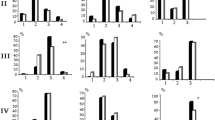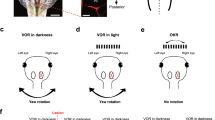Abstract
UNILATERAL vestibular nerve transection is followed by postural and locomotor disturbances that disappear to a large extent with time after the lesion1. This compensation requires a central readjustment of the tonic and phasic output from the remaining vestibular apparatus to the motor nuclei involved in the control of limb and head muscles. To study the mechanisms of this type of motor learning at the single neurone level, we have used the frog (Rana temporaria), because in this species the time course of the postural compensation following hemilabyrinthectomy has been thoroughly studied2. Furthermore, the synaptic circuitry and functional organisation of the peripheral and central vestibular systems are well known for this species3. Since the vestibular nuclei are the first integrative structures in which bilateral vestibular and other sensory inputs converge, and since their output influences motor systems directly or indirectly, we began to look for plastic changes in second order vestibular neurones. Many of these neurones are monosynaptically excited from the ipsilateral4 and disynaptically through commissural fibres from the contralateral5 labyrinth.
Similar content being viewed by others
References
Schaefer, K. P. & Meyer, D. L. in Handbook of Sensory Physiology, VI/2 (ed. Kornhuber, H. H.) 463–490 (Springer, Berlin, Heidelberg & New York 1974).
Kolb, E. Z. vergl. Physiol. 37, 136–160 (1955).
Precht, W. in Frog Neurobiology (eds Llinás, R. & Precht, W.) 481–512 (Springer, Berlin, Heidelberg & New York, 1976).
Precht, W., Richter, A., Ozawa, S. & Shimazu, H. Expl Brain Res. 19, 377–393 (1974).
Ozawa, S., Precht, W. & Shimazu, H. Expl Brain Res. 19, 394–405 (1974).
Fadiga, E. & Brookhart, J. M. Am. J. Physiol. 198, 693–703 (1960).
Rall, W. Neurophysiology 30, 1138–1168 (1967).
Hillman, D. E. Prog. Brain Res. 37, 329–339 (1972).
Fuller, P. M. Brain Behav. Evol. 10, 157–169 (1974).
Tsukahara, N., Hultborn, H., Murakami, F. & Fujito, Y. J. Neurophysiol. 38, 1359–1372 (1975).
Nakamura, Y., Mizuno, N. Konishi, A. & Sato, M. Brain Res. 82, 298–301 (1974).
Kuffler, S. W., Dennis, M. J. & Harris, A. J. Proc. R. Soc. B177, 555–563 (1971).
Precht, W., Shimazu, H. & Markham, C. H. J. Neurophysiol. 29, 996–1010 (1966).
Author information
Authors and Affiliations
Rights and permissions
About this article
Cite this article
DIERINGER, N., PRECHT, W. Modification of synaptic input following unilateral labyrinthectomy. Nature 269, 431–433 (1977). https://doi.org/10.1038/269431a0
Received:
Accepted:
Issue Date:
DOI: https://doi.org/10.1038/269431a0
- Springer Nature Limited
This article is cited by
-
Physiological changes of premotor nonspiking interneurons in the central compensation of eyestalk posture following unilateral sensory ablation in crayfish
Journal of Comparative Physiology A (2007)
-
Sprouting and formation of new synapses in motor structures of the central nervous system
Neurophysiology (1995)
-
Molecular mechanisms of Brainstem plasticity
Molecular Neurobiology (1991)
-
Excitatory amino acid receptors in normal and abnormal vestibular function
Molecular Neurobiology (1991)





